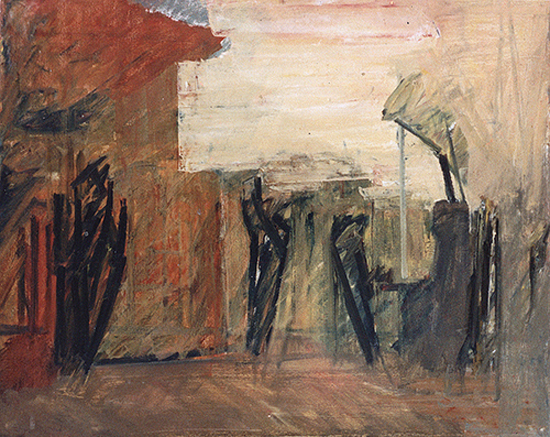
Dobrica Bisenić, Untitled, oil on canvas, 2000.
Love and only love will break it down.
Neil Young, Ragged Glory, Reprise, 1990.
In our times, preoccupied with so many serious issues, the consideration of the difference between stroke and line could seem bizarre or frivolous was it not the key issue of one of the most outstanding and simultaneously one of the most unnoticed Yugoslav painters. And while the thorough reflection on this rather contradictory position is best left to the artist – Dobrica Bisenić – his rare audience is rewarded with a pure painterly bravura of his production.
Bisenić’s work emerges from the conflict between the regressively desired consistency of the flow and the risky but potentially cathartic cut, rupture, discontinuity. Carefully integrated with its environment, the stroke has the principal operative-formal role in Bisenić’s paintings that openly materialize the process of their own creation. Even their surfaces, never totally flat, are constructed with stroke-like cuts of the painting knife, while the one-dimensional ascetism of the painted stroke concurrently builds and deconstructs the sense of simulated spatiality. As a visual essence of Bisenić’s work, the power of the stroke is materialized through the fusion of figuration and abstraction.
The contest between stroke and line is, nevertheless, not merely technical or academic in nature because, on the level of creative ethics, it requires responsible, precise and obligatory, if not always definitive, decision making. By its radical affirmation of drawing discipline, largely disregarded today, the stroke in Bisenić’s work reveals the crusty inferiority and corrupted ignorance of contemporary art world. At the same time, its exclusivity pierces the thick layers of existential mud from which it originates, enforcing a certain symbolic perspective through geometric articulation. Thus an old story, that is always worth repeating in the Balkans, about the individual will and effort that, in spite of the horrifying inertia of the environment, manage to overcome the traditional impediments of blood, soil and ‘fate’ as well as the trendy manias, finds a warning embodiment in Bisenić’s paintings.
Nevertheless, the story is spiced with a wise self-irony since, exactly within the process of patient picture building that requires continual self-critical pauses, re-questionings and over-paintings, the stroke establishes itself as a humble constituent of its own opposition – the unpredicted linearity. In Bisenić’s work, however, the indicated and present linearity is always ultimately ‘tamed’. These twists imply that the drawing algorithm which simultaneously invokes and cancels the optical illusion is not just a device of aesthetic or physical pleasure, but a tool for intimate self-reflection. It remains impervious despite its thematic and formal transparency, and its real contents are hidden deeply within the artist’s unique perception.
Dobrica Bisenić, Paintings, exhibition catalogue, ULUS Gallery, Belgrade, 2002.